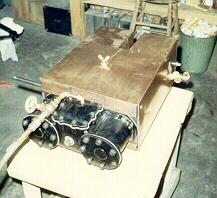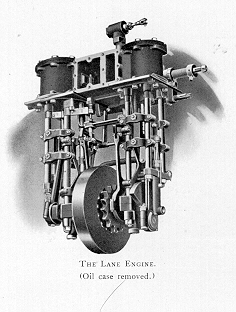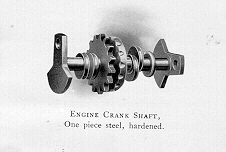
The Lane Automobile Engine
By
Arthur Eldredge
In my previous article I described the Lane burner. This time I will endeavor to enlighten the reader about the Lane engine. The Lane brothers designed their own engines for their cars. They did not purchase engines from other makers, as was common practice in the early twentieth century.
I will start the discussion with the early engine design, which was in use from the beginning of production to about 1904. The early engine was a two cylinder, simple, slide valve affair with Stephenson link valve gear. The engine was of a bar frame design (four bars) with bronze stiffening webs between the bars. The crankshaft was fabricated from one piece of steel. All bearings in the engine were plain bearings or bushings. The main bearings were bronze inserts (like a modern gas car) fitted in what were essentially brass pillow blocks. Connecting rod bearings were hardened steel bushings at both ends of the rods. Two pumps were driven off the crossheads; the boiler feedwater pump and air pump for maintaining fuel pressure.

The entire running gear of the engine was enclosed in a copper case, which was partially filled with oil.
The cylinder block is a single casting. Unlike a Stanley it only has removable cylinder heads on the top end of the block and they were bolted on. The steam chest cover similarly was bolted onto the block. There was no provision for cylinder lubrication other than the condensation from the saturated steam and any oil that would creep past the piston rod packing. Piston diameter is about three inches and stroke is about four inches.
How does this engine behave? Very well indeed! My car is a 1901 Model 0 runabout with the above-described engine. There is one small modification on this car that allows for engine valve lubrication. When my father restored the car, it was discovered that a 1/8 pipe fitting had been added to the steam chest cover. My father acquired a very pretty Lunkenheimer lubricator, which he installed on the car. It works very well as I can give the valves a shot of oil as needed by simply pumping the handle on the lubricator once or twice.
Crankcase lubrication initially was problematic as I had problems with the oil emulsifying if there was any water contamination. There always will be some water getting by valve and piston rod packing and the boiler feed pump packing. It was suggested by an English steam enthusiast that I try Sentinel crankcase oil made by Morris Lubricants in England. This oil, based on 600W steam cylinder oil is specially formulated so that any water in the oil will separate out as soon as the engine is stopped. I acquired a sample from a friend and it proved most satisfactory. I have since acquired my own supply, which will now last me for some time.
In or about 1904, the Lane engine design changed. This new engine was a cross-compound type. It was still a bar frame design with crosshead driven pumps.

The crankshaft differed from the earlier ones in that the chain sprocket was off center and a flywheel was added at the center of the crankshaft. The crankshaft was still a one-piece steel affair, which must have been quite a machining project to fabricate. The main bearings were now roller bearings and the eccentrics and crossheads were ball bearing.

It should be noted that the steam chests were adjacent to each other and the valves were slide valves. There was a simpling device to facilitate starting the engine. The description is as follows and I quote from the Lane catalog of about 1906.
"The simpling device is arranged on the back of the steam chests. A small cylinder has ports connecting directly with the high-pressure exhaust, the high and low-pressure steam chests, and the free exhaust. There is a one-piece plug valve having proper passages through it, carefully fitted to this cylinder and arranged so that the different rotative positions effect the changes of ports for converting the engine from compound (using steam first in small, and afterward in the large cylinder) to single expansion (using high pressure directly in both cylinders)."

These later engines were made in both twenty and thirty horsepower sizes, which were no doubt needed, as the cars were much larger and heavier. I know of only one surviving example of a late Lane automobile. This car was in the Ford museum for many years but is now in private hands. The owner has told me that he found it to be quite a nice running car once he got it sorted. Unfortunately, it has not been run in recent years. Maybe I can entice him to get it running again. We shall see...
A final note: If any readers would like further information on Sentinel crankcase oil, I can reached via e-mail at aseldredge@monad.net or via the USPS at: 537 East Mountain Road, Peterborough, NH 03458.
Back to Papers